Searching through America’s past for the last 25 years, collector James Allen uncovered an extraordinary visual legacy: photographs and postcards taken as souvenirs at lynchings throughout America. With essays by Hilton Als, Leon Litwack, Congressman John Lewis and James Allen, these photographs have been published as a book “Without Sanctuary” by Twin Palms Publishers . Features will be added to this site over time and it will evolve into an educational tool. Please be aware before entering the site that much of the material is very disturbing. We welcome your comments and input through the forum section.
Experience the images as a flash movie with narrative comments by James Allen, or as a gallery of photos which will grow to over 100 photos in coming weeks. Participate in a forum about the images, and contact us if you know of other similar postcards and photographs.
When you are finished viewing Without Sanctuary, please take a moment to register with Journal E. The confidential information you give will aid us in bringing you more compelling online presentations.
© 2000-2005 Collection of James Allen and John Littlefield
——————————————————————————————–
The corpse of Clyde Johnson. August 3, 1935 . Yreka, California. Gelatin silver print. Real photo postcard. 3.1/2 x 5 3/8 in. Etched in the negative, “Killer of Jack Daw Aug 3, 1935 vengence in Siskiyou County.”
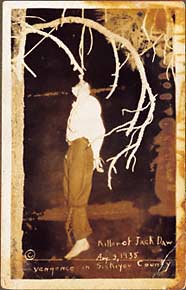
At the funeral of Dunsmuir, Oregon’s Chief of Police, F. R. Daw, a number of mourners planned the lynching of his alleged murderer, Clyde Johnson. Early on the morning of August 3, 1935, the masked mob, estimated as large as fifty, forcibly removed Johnson from his jail cell and dragged him three miles south of town where they hung him from a pine tree. Local and state officials expressed mixed reaction to news of the lynching.
District Attorney James Davis declared that he would open an investigation and “do everything the law requires to apprehend members of the mob.” On the other hand, the California Attorney General, referring to the recently delayed execution of an accused murderer, stated that the “uncontrollable unrest” was a natural result of the “apathy of the Supreme Court of the United States.”
——————————————————————————————–
Unidentified corpse of African American male. Gallows, courthouse-jail, and windmill in background. Nine onlookers, two young boys. 1900-1915. Location unknown. Gelatin silver print. Real photo postcard. 3 x 5 in. The architectural details of the courthouse in the background suggest a Texas origin. Found in Texas.
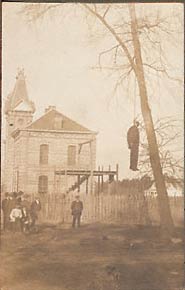
——————————————————————————————–
Unidentified corpse of African American male. 1900-1915, Trenton, Georgia. Gelatin silver print. Real photo postcard. 3 x 5 in. A pencil inscription on the reverse reads, “Dade County Trenton, Georgia.” Purchased in Georgia.
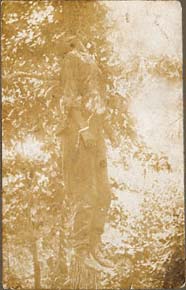
——————————————————————————————–
Bennie Simmons, alive, soaked in coal oil before being set on fire. June 13, 1913. Anadarko, Oklahoma. Gelatin silver print. Real photo postcard. 31/4 x 5 in. Itched into negative, “Edies Photo Anadarko Oklo”.
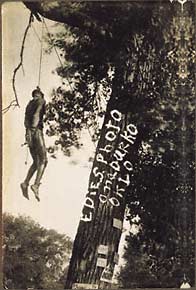
Bennie Simmons, or Dennis Simmons, accused of the murder of sixteen-year old Susie Church, was taken from prison guards in Anadarko, Oklahoma. His killers led him to a nearby bridge and hanged him from the limb of a cottonwood tree flourishing by a stream. ”
The Negro prayed and shrieked in agony as the flames reached his flesh,” reported a local newspaper, “but his cries were drowned out by yells and jeers of the mob.” As Simmons began to lose consciousness the mob fired at the body, cutting it to pieces. ” The mobsters made no attempt to conceal their identity,” remarked the Enfaula Democrat, “but there were no prosecutions.” Purchased in Oklahoma.
——————————————————————————————–
The corpses of George and Ed Silsbee. January 20, 1900. Fort Scott, Kansas. A large group of spectators holding kerosene lamps, downed fence in foreground. Gelatin silver print. Cabinet card. 7 x 10 in.
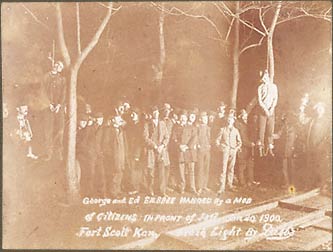
Etched in negative, “George and Ed SILSBEE HANGED by a MOB of CITIZENS IN FRONT OF JAIL. Jan. 20, 1900. Fort Scott Kan. Flash Light by Dabbs”
Sticker on reverse side of postcard:
J.V. DABBS PHOTOGRAPHER GROUND FLOOR STUDIO, Frames and Mouldings, 407 Market Street. FORT SCOTT, KANSAS.
——————————————————————————————–
View the full collection here on Without Sanctuary